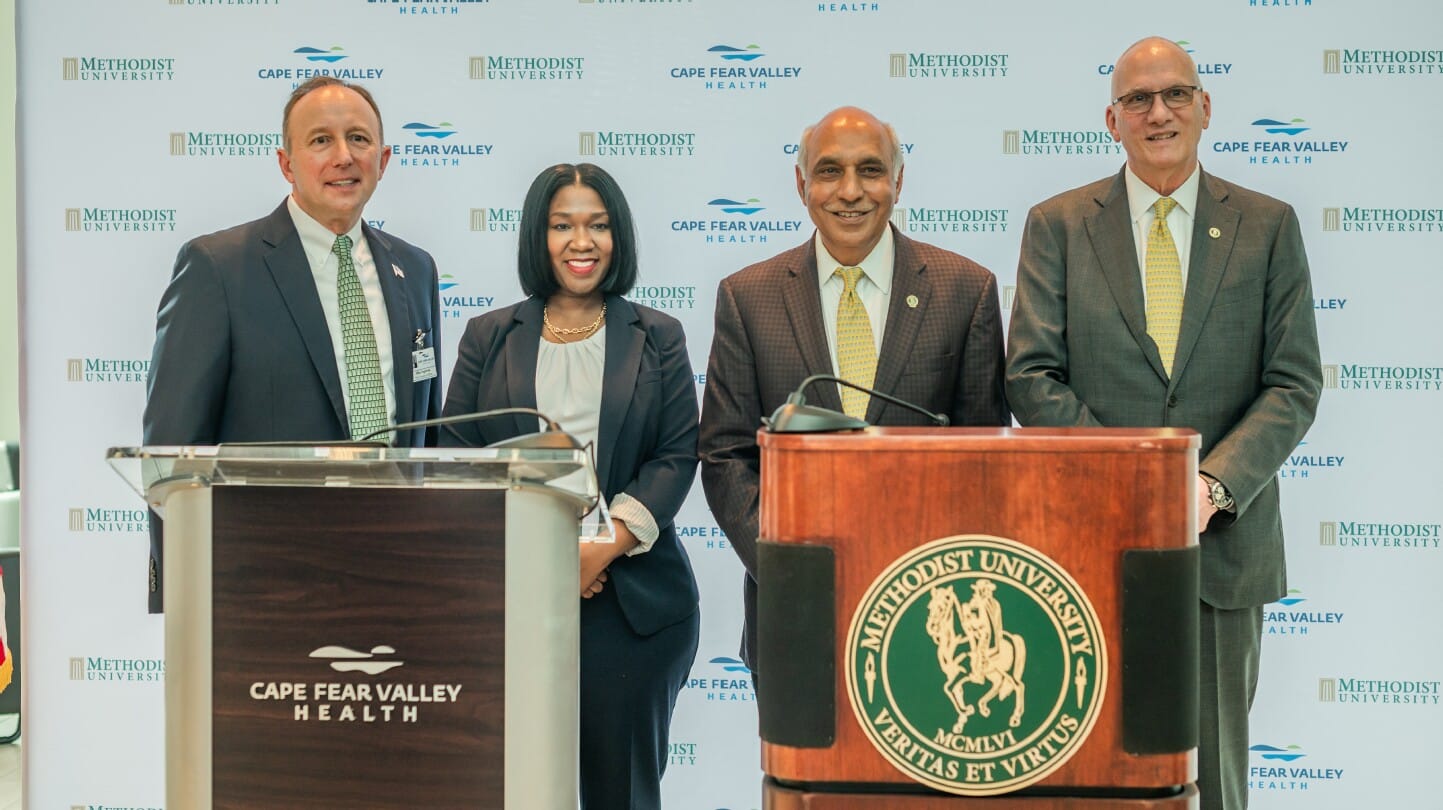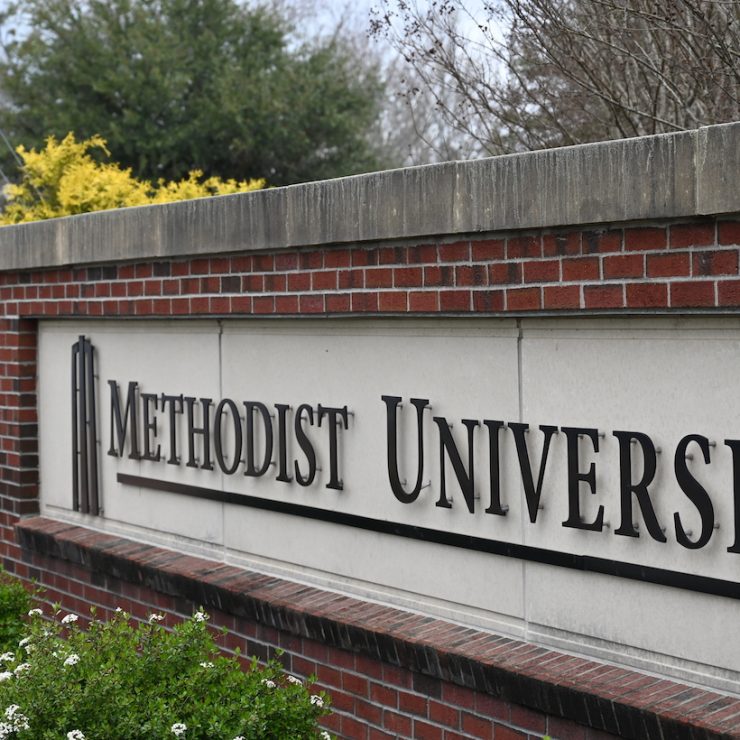
A Brief History of Methodist University
Written by William H. Billings ’68, Michael C. Molter ’94, and Kim Hasty
Edited by Michael C. Molter ’94
The Founding of Methodist College: 1956-1960
In 1955, a citizens’ group in Fayetteville, N.C., began discussing the possibility of bringing a private college to the city. The Presbyterian Synod of North Carolina had just announced plans to build a four-year college somewhere in eastern North Carolina, and many local leaders were hopeful that Fayetteville could attract that institution. After the Presbyterians selected Laurinburg as the site for their new college, the mayor of Fayetteville appointed the “Fayetteville College Steering Committee” to formulate a proposal for bringing a Methodist college to town.
The Fayetteville (later Methodist) College Foundation was created to secure pledges of land and money. During 1956, Fayetteville attorney Terry Sanford and other foundation leaders met with Bishop Paul Garber of the North Carolina Conference of the Methodist Church and his cabinet and formally invited the conference to establish a four-year, coeducational college in Fayetteville. The group pledged 600 acres of land, $2 million for initial construction of the campus, $50,000 annually for sustaining funds, and city utilities as well as police and fire protection for the site. Bishop Garber’s Long Range Planning Committee voted to accept the Fayetteville group’s offer and a similar offer from Rocky Mount; the committee also proposed to move Louisburg College to Rocky Mount and convert it into a four-year college.
At a special session on May 14, 1956, the North Carolina Conference of the Methodist Church formally accepted the Fayetteville group’s offer, voting to build senior colleges in Fayetteville and Rocky Mount and to retain Louisburg College as a junior college. As part of its plan for expanding higher education, the North Carolina Conference also voted to launch a $5 million fund drive to build the two new colleges and help Louisburg; each of the two new senior colleges was to receive $2 million toward initial construction.
In July 1956, a Methodist College Board of Trustees was organized, and Fayetteville attorney Terry Sanford was elected board chairman. Methodist College was chartered by the state of North Carolina on Nov. 1, 1956 as a senior, coeducational, residential college of liberal arts and sciences.
The Weaver Administration: 1957-1973
In June 1957, the trustees named L. Stacy Weaver, superintendent of the Durham City Schools and an active Methodist lay leader, the first president of Methodist College. The addition of Weaver would reverberate through the years.
“Having Dr. Weaver as President gave Methodist College instant credibility,” Dr. M. Elton Hendricks, Methodist’s third President, would go on to say in 1997. “He was one of the most respected educators in North Carolina. Even after all these years, we still benefit from that reputation.”
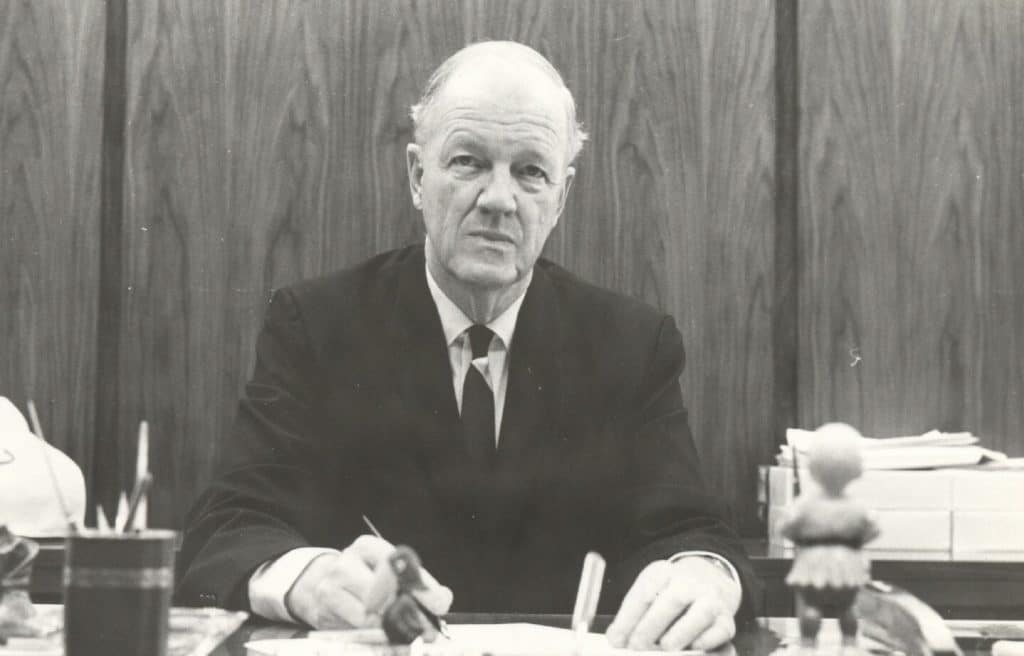
Seeking a thoroughly “modern” look, the trustees retained the architectural firm of Stevens and Wilkinson of Atlanta to design the campus. The end result was a campus consisting of three terraced, interlocking malls and contemporary buildings with vaulted roofs and masonry sunscreens. Site preparation for the campus and construction of the first four buildings began in the fall of 1958.
In September 1960, Methodist College opened for business with 88 full-time students, 40 part-time students, 12 faculty members, and four buildings: the Classroom Building (later named the Trustees Building), the Student Union (later named in honor of Mr. and Mrs. Karl H. Berns), the Science Building, and the Boiler Plant. More construction followed. Three apartment buildings (temporary dormitories) and a temporary gymnasium were built in 1961 and 1962. During 1963 and 1964, the Yarborough Bell Tower, Davis Memorial Library, and four large residence halls (Cumberland, Garber, Sanford, and Weaver) were completed.
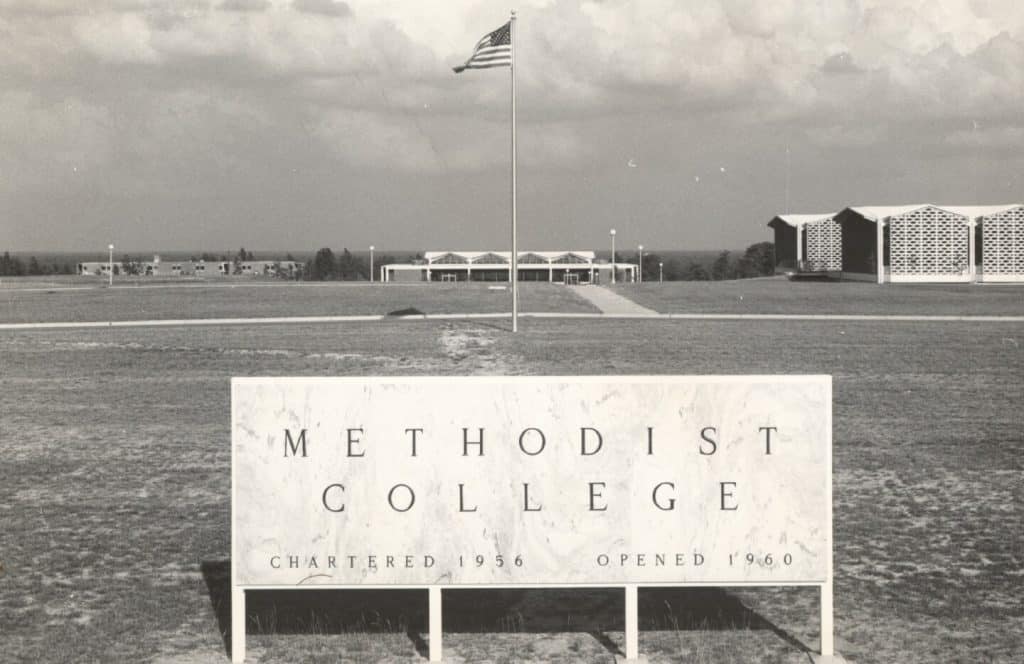
Intercollegiate sports began in the fall of 1963. As a member of the Dixie Intercollegiate Athletic Conference, Methodist initially fielded teams in cross country, golf, basketball, bowling, tennis, adding soccer, wrestling, track and field, and baseball over the next six years. Methodist was affiliated with the National Association of Intercollegiate Athletics (NAIA) before joining Division III of the National Collegiate Athletic Association (NCAA).
On April 10, 1964, Weaver was inaugurated as the school’s founding president. Two months later, Methodist College celebrated its first graduating class of 43 students. Though he had been president for seven years already, it had been Dr. Weaver’s feeling that his inauguration should be postponed until the first senior class became a reality, “a full-fledged college having four classes on campus,” he said.
By 1965, Methodist had two new residence halls ready for occupancy, and the young institution had begun to establish the traditions that stand today. The College seal was designed early. The horse and rider in the center are a reproduction of a portrait of Bishop Francis Asbury, the first bishop of the Methodist Church in America, who is referred to as “The Prophet of The Long Road.” Written in Latin at the bottom of the seal, the Methodist College motto, “Veritas et Virtus,” means “truth and virtue.” The motto was designed to introduce the idea of joining together education and the Christian virtues of faith, hope, and love.
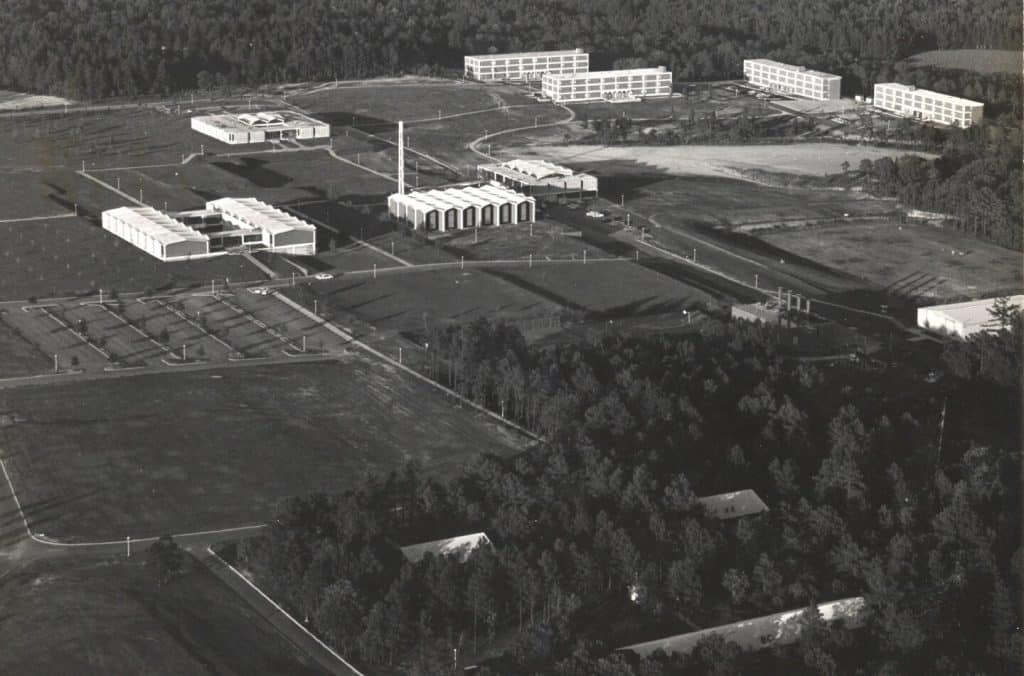
Methodist College received full regional accreditation from the Southern Association of Colleges and Schools in November 1966.
At a special assembly in 1967, Methodist College students selected a musical composition by Lois Lambie, a music teacher at Seventy-First High School in Fayetteville, as the College’s alma mater, and the Trustees adopted it as such later that year. Also in 1967, the College purchased a collection of medals, books, letters, and other memorabilia concerning Fayetteville’s namesake, the Marquis de Lafayette, which would be opened to the public in August 1992 as the Lafayette Collection, the Davis Memorial Library’s most celebrated special collection.
Enrollment grew steadily in the 60s, reaching a peak of 1,069 in 1967-68. New facilities were added, including the John M. Reeves Auditorium/Fine Arts Building, Horner Administration Building, and an addition to the Student Union in 1967-68. The Fleishman Fountain and Hensdale Chapel were built in 1969.
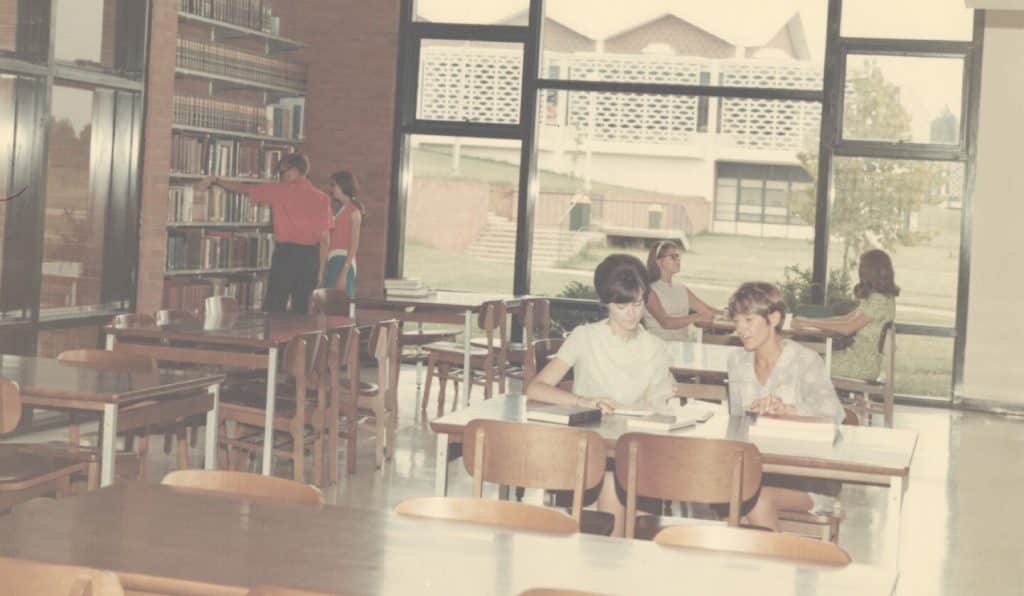
Although enrollment had declined as the College began its second decade, its programs and facilities continued to expand. O’Hanlon Amphitheater was built in 1971, and in the early 1970s, majors in art and physical education were added.
In 1973, Dr. Sid Gautam, an economics professor at Methodist College, established the Center for Entrepreneurship to strengthen ties between the College and the Fayetteville business community. The Center sponsored annual events, such as the Stock Market Symposium in the fall and Economic Outlook Symposium in the spring, that recognized local business leaders and entrepreneurs for their accomplishments. The Center and its events continued through 2016.
The Pearce Administration: 1973-1983
When Dr. Weaver retired in 1973, he was succeeded by Dr. Richard Pearce, vice president and dean at Florida Southern College and a Methodist layman with deep roots in The Methodist Church. Pearce did not like the phrase “church-related college.” “I had rather call it a church-involved college,” he said. One of Dr. Pearce’s first acts was to distribute a statement of principles to the trustees and the college staff and students; therein he declared that the College would honor its church-affiliation by strictly enforcing rules against substance abuse. In response to the Arab oil embargo and soaring energy prices, Dr. Pearce had the college boilers converted from fuel oil to natural gas, installed new energy-efficient lighting, and took other energy conservation measures.
Over the next 10 years, the Pearce administration was able to establish a more solid financial footing for the school. Dr. Pearce established a President’s List to recognize students who earned an “A” average each semester, and during his tenure, Shelley Baseball Field (now called Armstrong-Shelley Field) was completed and dedicated in 1974, as well as tennis courts and a track.
Declining enrollment, which bottomed out at 610 in 1973, forced the college to lay off faculty and staff, borrow from local banks for current operations, and default on federal loans used to build the first four residence halls. For most of the 1970s, the residence halls were only half-filled, housing as few as 250 students at one point. In 1974, as part of an effort to enhance residential life and retain more resident students, President Pearce approved the establishment of fraternities and sororities and the hiring of a full-time director for the Student Union.
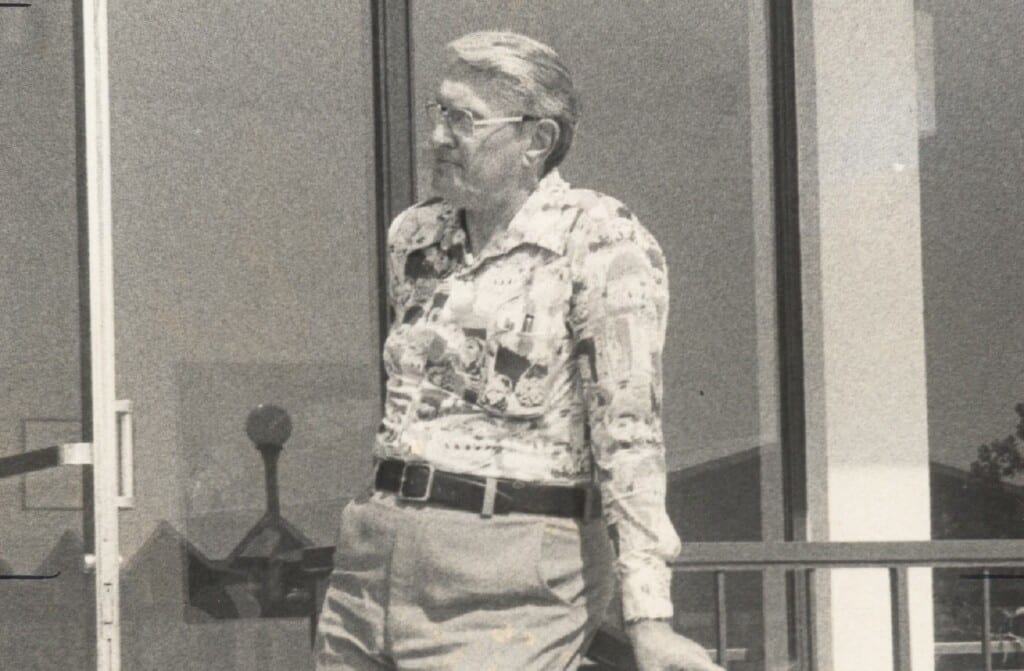
It was at Dr. Pearce’s behest that a home for the president was constructed on campus in 1975, built with the proceeds from the sale of the president’s former house in downtown Fayetteville. The site of the home on the north side of campus was chosen due to Dr. Pearce’s desire to be close to students and faculty. “Acquiring a residence near the students has been one of my goals since coming to Methodist College,” he said.
In 1975, the College launched an evening program. In 1976, Methodist was designated an American Bicentennial campus, and a gift from Mrs. Karl Berns provided a Schantz pipe organ for Hensdale Chapel. During the next two years, the road between Cumberland Hall and the Student Union was paved; the soccer field was enlarged and a track laid around it.
An Army ROTC program was added in 1977. In 1978, Methodist College began offering associate’s degrees. By 1979, enrollment had increased to 990, but only 360 students were living on a campus designed to house 600. Over the next four years, enrollment declined to 771, putting further strain on the College’s finances.
Methodist College held its first Southern Writers Symposium in 1982, founded and led by English professor Dr. Sue Kimball. The annual event featured distinguished Southern writers such as Reynolds Price, Doris Betts, Lee Smith, Jill McCorkle and others. After Kimball’s retirement, the Symposium was directed by Professors Mary Wheeling White (1997-2001), Emily Wright (2002-2009), and Brenda Jernigan (from 2011 through the 25th and final Symposium in 2015).
The Hendricks Administration: 1983-2010
Coming of Age: 1983-1989
Dr. Pearce announced his retirement after 10 years as president in 1983, staying on until the Presidential Search Committee passed the torch to Dr. M. Elton Hendricks, academic dean at Randolph Macon College in Ashland, Va., and a dedicated scholar with a doctorate in physics from the University of South Carolina and a Master of Divinity from Duke University. A year later, enrollment in the day program reached 760, showing a 15 percent increase over the preceding year. Women’s soccer was added to the intercollegiate athletic program in 1984.
In March 1986, Methodist College established the Charles M. Reeves School of Business to honor the Sanford, N.C. businessman, trustee, and benefactor. The Reeves School of Business established a concentration in Professional Golf Management in 1986, later accredited by the PGA of America, and a similar program in Professional Tennis Management the following year.
By the fall of 1986, enrollment had grown to 1,375 students for the day and evening programs combined. In 1986, the College established an Honor Code, began waiving tuition for senior citizens, and launched its first capital campaign, “Come of Age,” to raise $3.5 million to build a physical activities center, to be named for March F. Riddle. In 1988, the trustees approved the addition of Football to the Methodist athletic program (beginning in 1989), and the College held a ribbon-cutting and open house for the 18th-century Mallett-Rogers House, moved to campus and restored as the College’s first art gallery. A golf driving range, eight tennis courts, and a nine-hole golf course were built between 1988 and 1993.
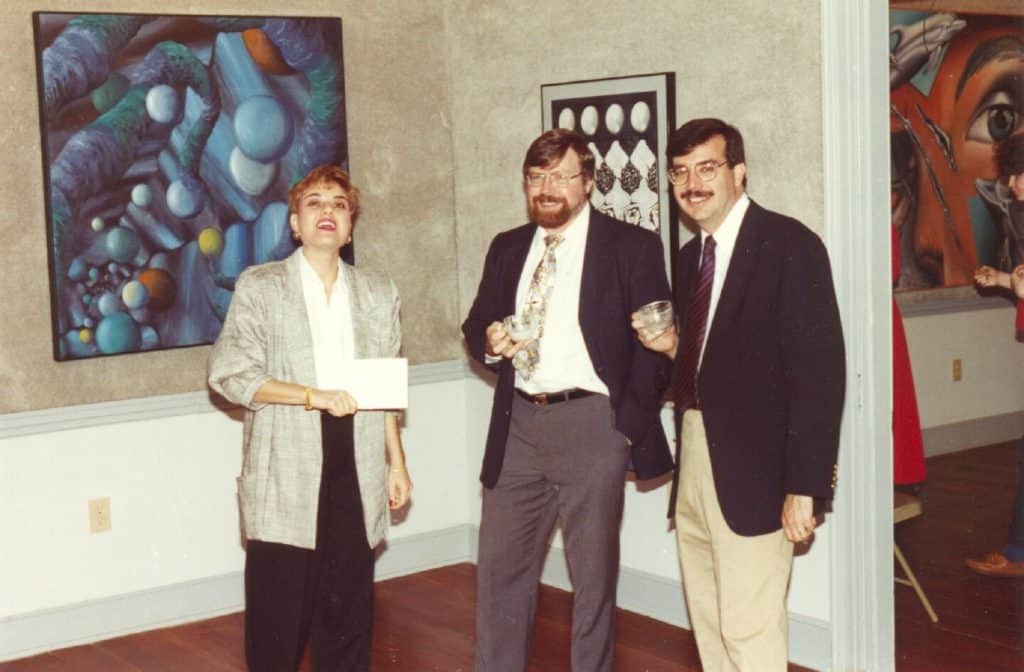
Expanding the Vision: 1990-2001
Methodist College began the 1990-91 school year with the opening of the new March F. Riddle Center and an enrollment of 1,447—969 day students and 343 evening students. Increased enrollment provided new opportunities. New majors were announced in International Relations and Criminal Justice. A mentoring/tutoring program was started in the fall of 1991. After two winless seasons, the Football program opened the 1991 season with its first win, defeating Charleston Southern 18-8. In May 1992, the college contracted with EUA/Highland Partners for a $1.5 million, two-year energy savings plan involving installation of new heating and lighting systems with electronic controls. The large boilers at the boiler plant were phased out. After the new systems went online in 1994, the College realized a 34 percent reduction in annual energy costs. A four-year project to replace underground electric cables was completed.
In June 1993, the Methodist College Board of Trustees approved a series of important planning recommendations presented by a Strategic Concepts Committee appointed by the president. Projecting “at least 2,000 students” by the year 2000, the committee recommended that the College borrow funds to build additional residence halls over the next five years to accommodate 300 new resident students and that the College undertake a major capital campaign for increasing the endowment and constructing a library addition, a new academic building, and a science building.
In 1994, the Methodist College Board of Trustees agreed to lease 30 acres of campus land (for a token fee) to a local non-profit group for construction of the Jordan Soccer Complex, a youth soccer complex consisting of eight fields.
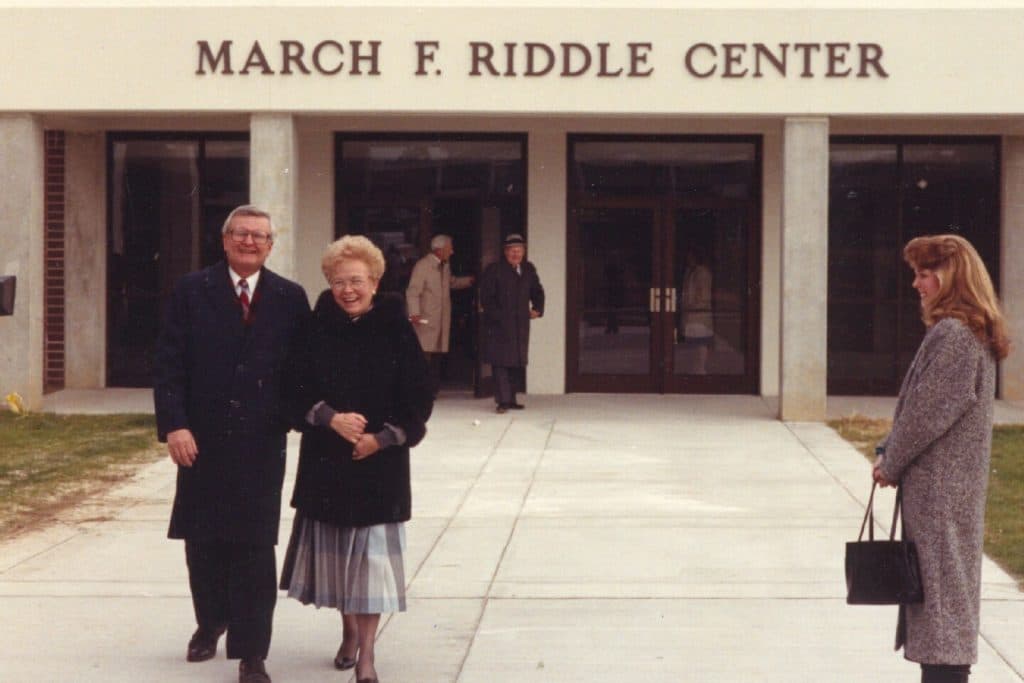
In the summer of 1994, the state attorney general’s office authorized the establishment of a campus police department at Methodist College, giving certified and sworn officers full arrest powers. In the fall of 1994, a new residence hall opened behind Garber Hall originally called East Hall but named in honor of President Pearce. The college launched a $6.5 million “Expanding the Vision” capital campaign to build an annex to the library, a math and computer science building, and a new academic building.
Methodist College began the 1994-95 school year with a record enrollment of 1,826 students—1,237 in the day program and 589 in the Evening College. In 1995, the College announced it would launch a Physician Assistant program in 1996. The Lura S. Tally Center for Leadership Development was established, allowing students to earn an interdisciplinary minor in leadership. Dr. Erik J. Bitterbaum resigned as academic dean, and Dr. Anthony J. Delapa, longtime chair of the Education Department at Methodist, was named his successor.
During 1995-96, West Hall was opened and the main entrance to the campus was realigned to meet a proposed stoplight. The Methodist College Development Corporation was chartered and granted a 50-year lease of 22 acres of college land (south and east of the main entrance) for development of the College Center Office Park.
In the summer of 1996, Methodist College dedicated the new Richard L. Player Golf and Tennis Learning Center. Joe W. Stout Hall, housing Enrollment Services, opened during the spring of 1997, followed quickly by the Medical Science Building, later known as the PA Academic Building. The Math and Computer Science Building, later renamed D. Keith Allison Hall, opened in the summer of 1997. The second nine holes of the college golf course were completed during the summer of 1998.
In 1999-2000, Margaret and Walter Clark Hall and the Library Annex opened. The Library Annex featured a new main entrance with an amphitheater, a new circulation desk area, and a second floor whose centerpiece was the Lafayette Room, a room that highlighted the College’s special collections. Fall 2000 saw the completion of Cape Fear Commons, the College’s first apartment-style, co-educational, residence hall.
In 2000, the University licensed the Blackboard learning management system to enable it to deliver both online courses and online instructional material to supplement traditional face-to-face courses. The Evening College piloted two eight-week online courses, CRJ 410 Medicolegal Investigation of Death and EDU 350 Educational Technology, which were well-received by students and faculty. Since then, Methodist University has offered online courses as options for students seeking scheduling flexibility within their traditional academic programs.
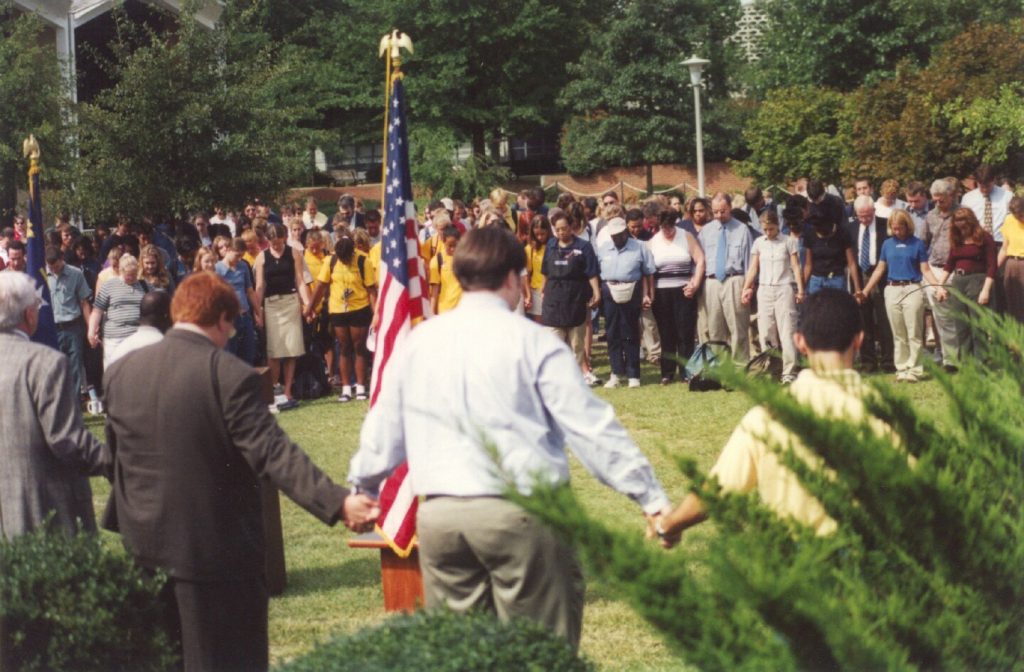
The Fall 2001 semester brought a record enrollment of 2,143, the enrollment of 10 students in the College’s first graduate program, the Master of Medical Science (Physician Assistant Studies) program, and the renovation of a brick home (dubbed Union Station) to house the Student Government Association, student activities personnel, and a coffee house. Union Station was renamed Chris’s House in 2004, in memory of Chris Ryan, director of student activities from 1989-2003.
A New Season: 2002-2006
In the spring of 2002, Methodist fielded its first Women’s Lacrosse team. In May 2002, the College announced the “Seeds on Good Soil, A New Season” campaign, a three-year effort to raise $11 million: $5 million to build an addition to the Science Building, $3.5 million to build a fitness and wellness center, $1.5 million for operating expenses, and $1 million for the College endowment. Cape Fear Commons II, a second apartment-style residence hall, was completed and occupied in the fall of 2002.
During the 2002-03 academic year, Dr. Delapa rebranded the Evening College “MU at Night” to market the fact that it was the same quality education as the Day program, just at night. When Delapa retired as academic dean, Dr. Philip C. Williams, assistant vice president for academic affairs at Gardner-Webb University in Boiling Springs, N.C., was named to the position and oversaw several major changes to academic programs, especially in graduate studies.
In December 2003, Methodist awarded its first master’s degrees to seven graduates of the Physician Assistant Program. In 2004, the College changed its academic structure by creating five schools, each with its own dean: The pre-existing Reeves School of Business was joined by the School of Arts and Humanities, the School of Public Affairs, the School of Science and Human Development, and the School of Graduate Studies. In 2005, the College launched the Professional MBA at Pinehurst, a hybrid online/weekend program taught in cooperation with the nearby Pinehurst Resort. In 2006, a Master of Justice Administration hybrid online/weekend program was established at the North Carolina Criminal Justice Academy in Salemburg, N.C.
In 2005-06, the College received $750,000 from the BB&T Foundation and a $550,000 challenge grant from the Kresge Foundation toward construction of the Science Building addition. Construction began in the fall of 2005 on the Science Building addition, the fitness and wellness center, and two new apartment-style residence halls near the golf driving range. The apartments were funded from a $24 million bond issue which also refinanced existing debt and provided initial construction funds for the Nimocks Fitness Center and the Science Building addition, as well as endowment and operating funds.
Helped by four $1 million gifts between 2003 and 2006, the “Seeds on Good Soil, A New Season” campaign exceeded its revised goal by $1.5 million, reaching a grand total of $14.7 million in gifts and pledges. Methodist received $1 million each from Elizabeth B. and David Nimocks, Jr., for the fitness center, Shelby M.C. and Gala Davis for the Davis World Scholars Program, the Thomas R. and Elizabeth E. McLean Foundation for the Science Building addition, and the estate of the Rev. Dr. William P. Lowdermilk, longtime College administrator and church relations liaison, for the William P. Lowdermilk Scholarship.
Dr. Williams resigned as academic dean in the summer of 2006 to become president of the University of Montevallo in Alabama. In November, President Hendricks announced the appointment of Dr. Delmas S. Crisp, Jr., academic dean at Wesleyan College in Macon, Ga., as Methodist’s new academic dean, effective June 1, 2007. Dr. Wenda Johnson, interim academic dean, was slated to become associate dean to Dr. Crisp, but died of a heart attack early in 2007. Following Dr. Johnson’s death, Mrs. Jane Weeks Gardiner, the longtime chair of the Music Department and founder of Friends of Music at Methodist, became interim academic dean, to become associate dean when Dr. Crisp arrived.
Creekside Apartments, two new apartment-style residence halls opened in August 2006, bringing total residential capacity to 956 students. Creekside was later renamed the McLean Residential Complex courtesy of a gift from the Thomas R. and Elizabeth E. McLean Foundation. Methodist began its 48th academic year in the fall of 2006 with the largest freshman class (417) and the largest number of Presidential Scholars (171) in school history. Enrollment reached 2,100 students.
From College to University: 2006-2010
Methodist observed the 50th anniversary of receiving its charter on Nov. 1, 2006, with a special convocation and announcement. President Hendricks announced that the Board of Trustees had voted unanimously to change the name of Methodist College to Methodist University.
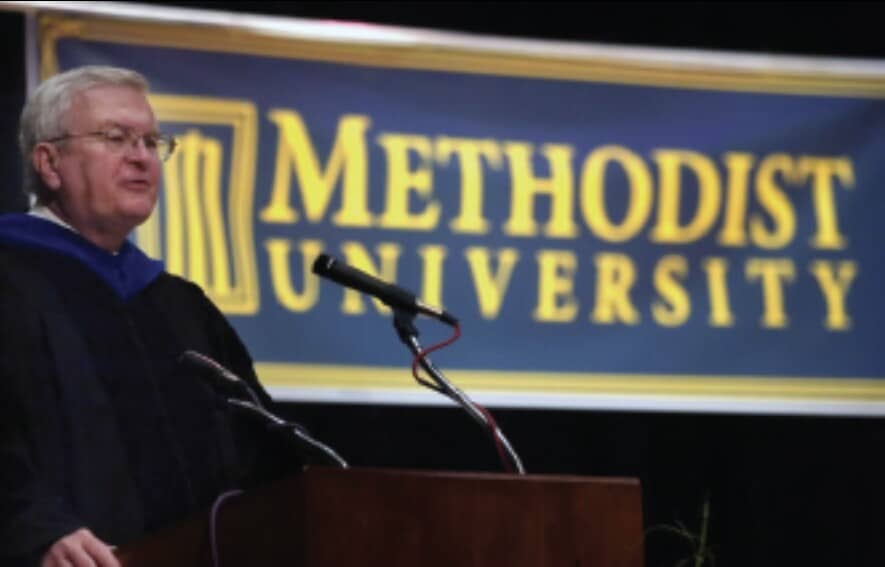
In the 2007-08 academic year, Methodist University received a federal Title III grant to improve technology. The grant, in the amount of $2 million to be awarded over a five-year period, allowed the University to purchase a student information system, Jenzabar, to handle course registration, payments, and much more, which was styled the myMU Portal. The grant allowed for the hiring of an instructional technologist, and numerous classroom technology upgrades followed: laptops, projection systems and SMART boards, charging stations, and grants for faculty to integrate technology into their teaching.
The University’s Physician Assistant Program added state-of-the-art facilities in 2010, when the Medical Lecture Hall and the Human Anatomy Lab opened. In the years that followed, the program established itself as one of the premier Physician Assistant Programs in the region, with consistent 100 percent pass rates on the PANCE exam and an overwhelmingly high demand for the 40 seats in each cohort.
In the Fall 2010 semester, enrollment eclipsed 2,400 for the first time in the University’s history (2,416). When Dr. Hendricks retired in December 2010 after 27 years of service, he had been president longer than any of the 36 presidents then working at independent colleges and universities in North Carolina.
The Hancock Administration: 2011-18
Dr. Ben E. Hancock, Jr., who had served as vice president for university advancement at Ball State University from 2006-11, became Methodist University’s fourth president on March 1, 2011. In the seven years of Hancock’s presidency, the University completed its largest-ever fundraising campaign, “The Campaign for Methodist University: Building Excellence,” exceeding its $35 million goal by generating nearly $42 million for new facilities, programs, and endowment. A 2013 gift of $1.5 million from Linda and Ralph Huff renamed Reeves Auditorium as Huff Concert Hall.
Dr. Hancock announced the University would establish a co-curricular program called the MU Journey that would consist of four pathways—Leadership, Community Engagement, Global Education, and Undergraduate Research and Creativity. New centers were established to join the existing Lura S. Tally Center for Leadership. Fellowship programs were established in each center to recognize students who excelled in each pathway. Since the establishment of the Center for Global Education, more study abroad opportunities have been available to students, and the Center for Undergraduate Research and Creativity has helped encourage students’ intellectual growth by providing opportunities to present their work to the community, such as the research symposium each spring and the Monarch Review journal of student research.
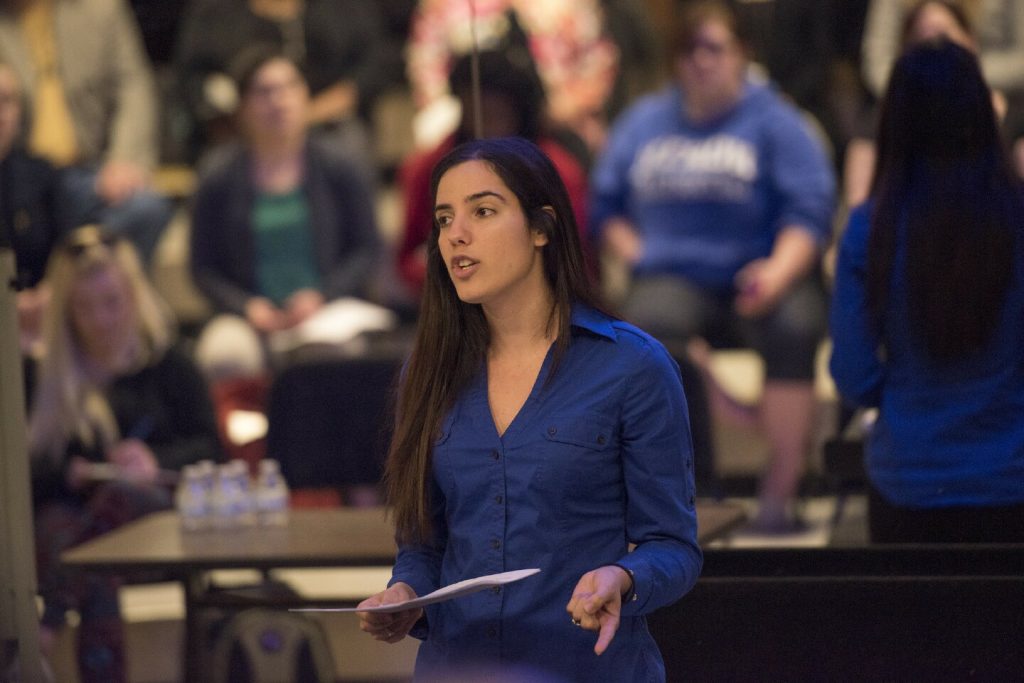
The University established the School of Health Sciences and began construction of the Thomas R. McLean Health Sciences Building and the Professional Nursing Studies Building, which house most of the School of Health Sciences’ programs. The School of Graduate Studies was disbanded in favor of organizing each graduate program into one of the other five schools, depending on the subject area. The new addition to the Science Building opened, and the old and new parts were renamed the Hendricks Science Complex, in honor of Dr. Hendricks and his wife, Jerry. The Professional MBA Program officially ended its partnership with the Pinehurst Resort and offered instead an on-campus focus on organizational leadership.
The University reached its record enrollment during the Fall 2011 semester—2,476 students. In 2012-13, a series of campus building improvements included a renovation of the library that reopened the central mall entrance, modernized the circulation area, and provided new facilities for a Writing Center and a Tutoring Center. Berns Student Center was remodeled to include a new bookstore, convenience store, a Starbucks, and a Chick-fil-A restaurant. The front and rear entrances to the Trustees Building also received a face lift, a brick streetscape was added on Lowdermilk Drive, and a sidewalk with a new sign and brick wall was added along Ramsey Street.
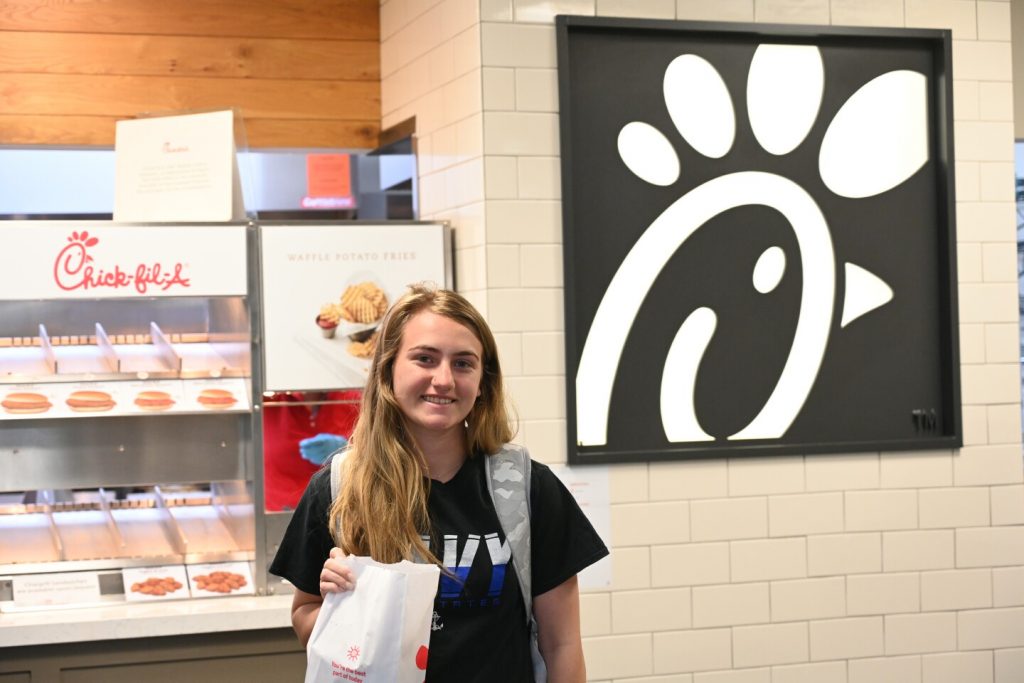
The William F. Bethune Center for Visual Arts was constructed as the new home for the Art department on campus, and it included the state-of-the-art David McCune International Art Gallery, which has drawn visitors to campus not only for exhibitions by local and regional artists, but also for big names such as Picasso, Rodin, and Warhol. The Professional Tennis Management faculty and tennis coaches moved into the new Gene Clayton Tennis Center, named in honor of the longtime administrator and hall-of-fame coach. The Armstrong Baseball Field House, Football Field House, North Hall (the newest residence hall), and an expansion to Village housing also were completed.
In 2012, the Methodist University Athletic program announced that it would be adding its 20th NCAA Division III intercollegiate sport, Men’s Lacrosse, to begin play the following season. Also in 2012, the Monarchs’ Women’s Golf team captured its 15th consecutive NCAA-III National Championship, bringing the program’s total to 25 national championships. The Men’s Golf team, after capturing nine national championships in the 1990s, made numerous NCAA tournament appearances before winning again in 2010, 2015, 2018, and 2022 to bring their program’s total to 13 national titles.
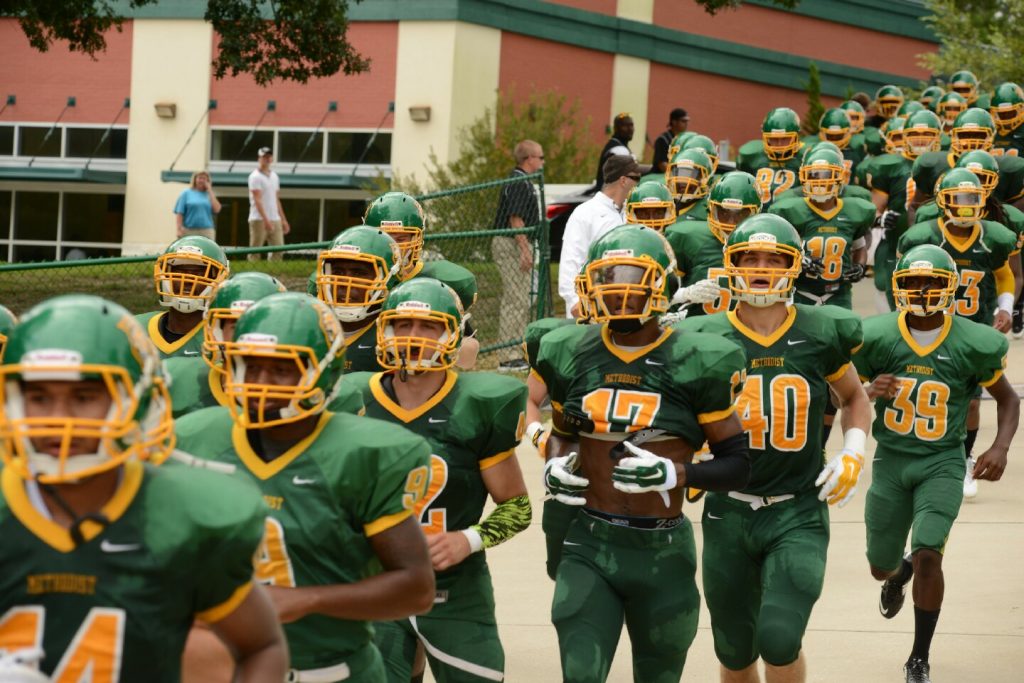
In 2015, Methodist University officially enrolled its first doctoral students, as its first doctoral-level program in Physical Therapy moved into the the McLean Health Sciences Building. In 2018, an entry-level doctoral program in Occupational Therapy also made McLean its home, enrolling its first students in the fall.
When Dr. Hancock retired in May 2018, the University embarked on a national search for a new president. Dr. Crisp, now the school’s provost, took on the additional role of interim president. Crisp, who had served briefly as interim president following the retirement of Hendricks in 2010, served in the dual role of provost and interim president until he retired at the end of December 2018. The Sharon and Ron Matthews Ministry Center opened late in the fall semester, connected to the John M. Reeves Fine Arts Complex by the Union-Zukowski Lobby and Gallery.
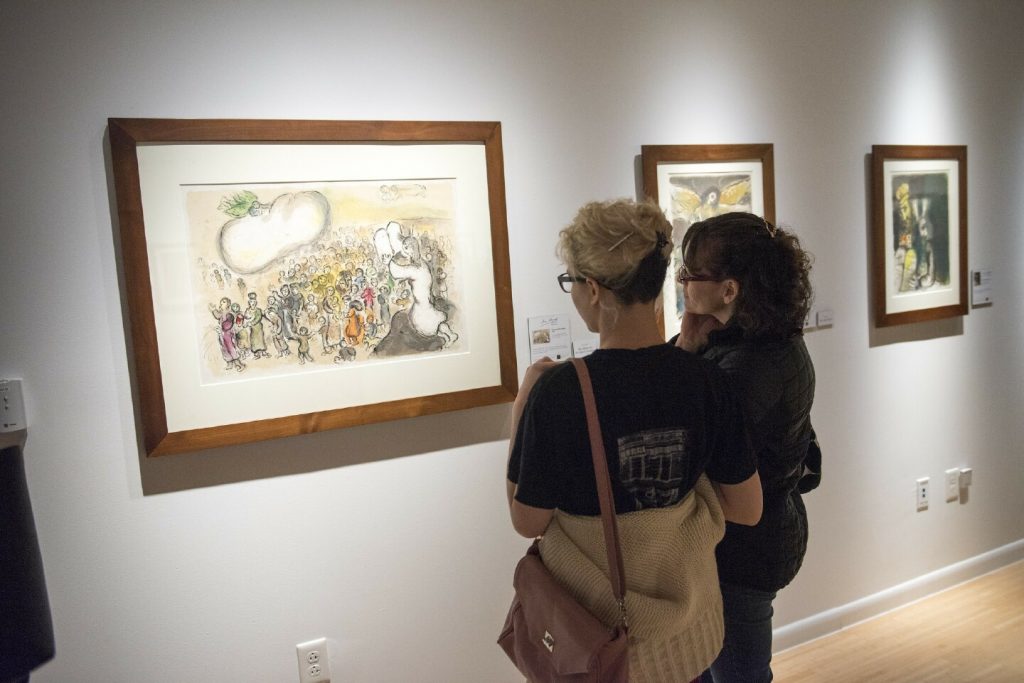
The Wearden Administration: 2019-Today
In October 2018, the Presidential Search Committee announced that Dr. Stanley T. Wearden, senior vice president and provost of Columbia College Chicago, would become the fifth president of Methodist University on Jan. 1, 2019. Dr. Wearden had previously lived in North Carolina when he obtained his Ph.D. in Mass Communication Research from the University of North Carolina at Chapel Hill in 1987.
At Dr. Wearden’s inauguration in September 2019, he announced plans to improve service for active duty military, veterans, and their families. He proposed cultivating partnerships with community colleges to encourage students with associate’s degrees to transfer to Methodist. He also stated that the University would be expanding its selection of online programs “to position ourselves as a university for life.” He spoke of a greater international presence for Methodist University, both in welcoming more international students to campus and in sending more MU students for study abroad opportunities.
“The Board of Trustees is excited to have Dr. Wearden as Methodist’s fifth President,” said Board of Trustees Chairman Mac Healy. “His vision, experience, and energy helped to convince us that Dr. Wearden is the right leader for this time in the life of Methodist University.”
The next three years saw the implementation of part of Wearden’s vision. Dr. Suzanne Blum Malley assumed the duties of provost in January 2020, joining Wearden from Columbia College Chicago. Methodist University entered into articulation agreements with regional community colleges as “transfer partners” to make it easy for students graduating with associate’s degrees from those schools to enroll at Methodist to complete their four-year degree. Several new 100% online programs were announced that would be implemented over the next few years, including a Master of Business Administration (MBA), Master of Health Administration (MHA), and bachelor’s programs in Accounting, Business Administration, Computer Information Technology, Health Care Administration, Criminal Justice, Psychology, Social Work, and more.
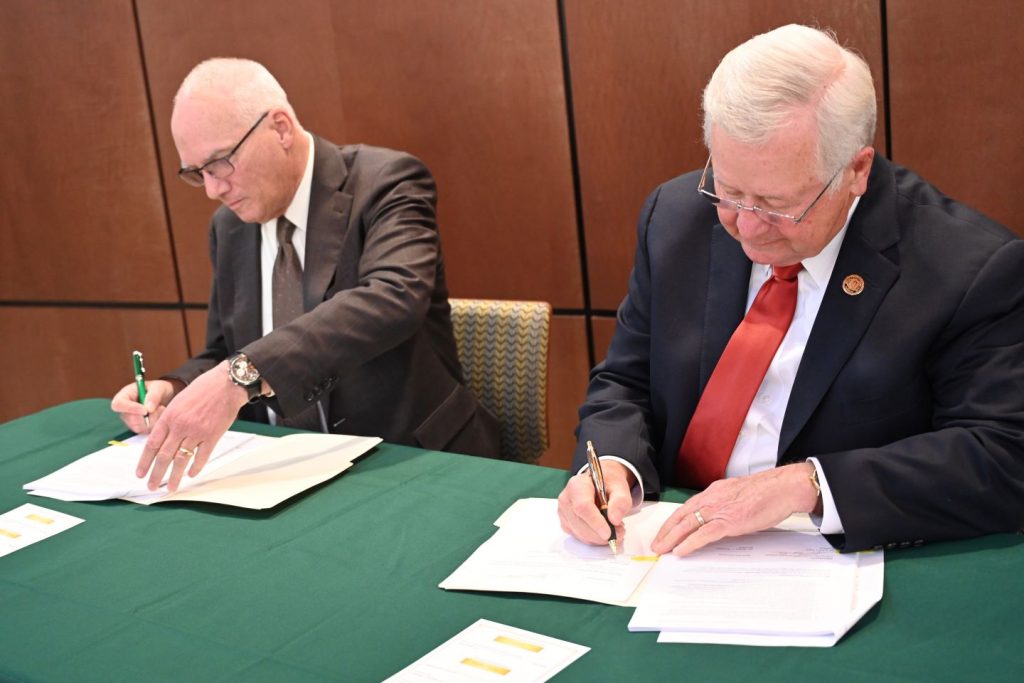
Other opportunities for enrollment growth were stunted by the sudden onset of the COVID-19 pandemic, which resulted in traditional courses shifting to an online environment in March 2020. The Summer 2020 semester was the first (and only) semester to be offered online in its entirety. It was also the last semester of the University’s licensing of Blackboard for online education, as the campus moved to the Canvas learning management system for the 2020-21 academic year. In order to welcome students back to campus in the Fall, an Epidemic Response Team developed a set of guidelines for limited gatherings, mask wearing, and social distancing. The University Relations department developed a slogan, “Forward Together,” and a website to encourage the spread of news, information, and sense of community—not the virus. Due to the efforts of faculty, staff, and students, the University remained open during the Fall semester, though many other North Carolina colleges and universities shut down their in-person operations. Major campus events shifted to virtual environments during the pandemic, including celebrations for graduates, since in-person commencements could not take place.
The 2020-21 academic year opened with a reorganization of academic departments. The previous five Schools were replaced with three Colleges: the College of Arts, Humanities, and Sciences; the College of Business, Technology, and Professional Studies; and the College of Health Sciences and Human Services. Also in Fall 2020, although sports seasons were postponed due to the pandemic, the University completed construction of the Nancy and Murray Duggins Soccer Stadium, thanks to their generous financial support of the project. The Spring 2021 semester was one like no other for Monarch Athletics, as both fall and spring sports teams held abbreviated seasons, culminating in the Football team playing for a conference championship and the Women’s Golf team capturing its 26th national championship. Due to the ongoing pandemic, the May 2021 commencement ceremony was held at Segra Stadium in downtown Fayetteville, the first time in the school’s history that the ceremony was held outdoors.
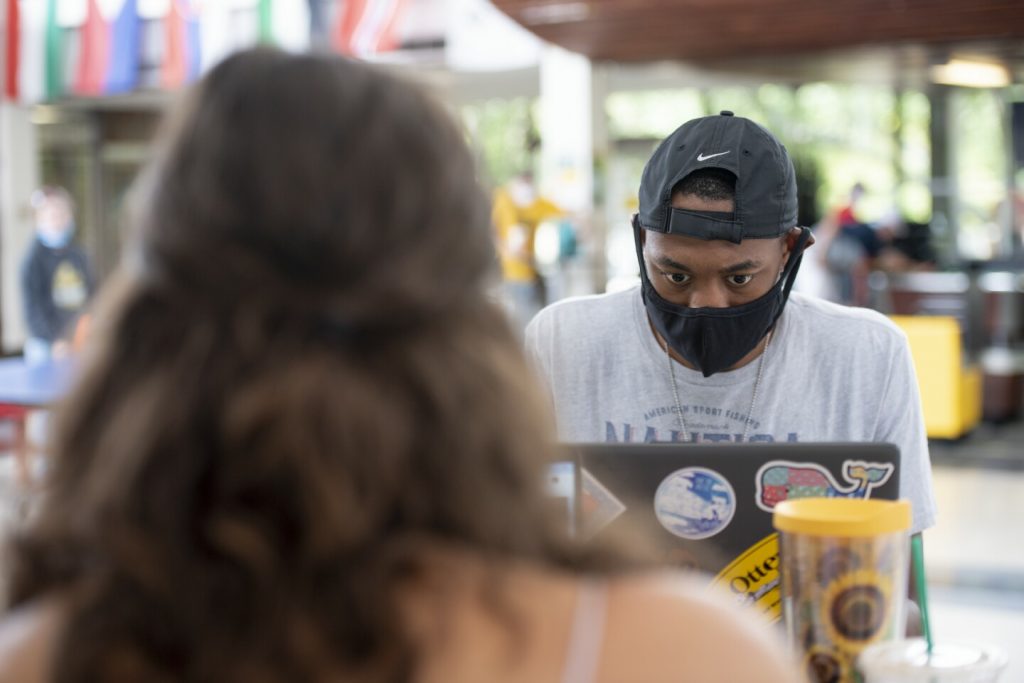
The 2021-22 academic year brought with it effective vaccines against COVID-19, leading the University to require vaccinations for all students, faculty, and staff who did not have a medical or religious exemption. The Fall 2021 “Vax to the Max” effort led to the University’s dropping its mandate for mask-wearing indoors in February 2022, and life at the University returned closer to its pre-pandemic norm. One year later, the vaccination requirement was downgraded to a recommendation in the wake of the receding pandemic.
Almost concurrently with the pandemic, Dr. Wearden established a Task Force for Racial Healing to do a careful, systematic study of issues of racial fairness, equity, and justice on the Methodist University campus. Based on its recommendation, the Office of Diversity, Equity and Inclusion was created, and MU alumnus Dr. Quincy Malloy was named Chief Diversity Officer, a cabinet-level position. The timing could not have been better; in 2022, Niche University Rankings and Reviews named Methodist University the No. 1 most diverse university in North Carolina and No. 56 in the entire United States.
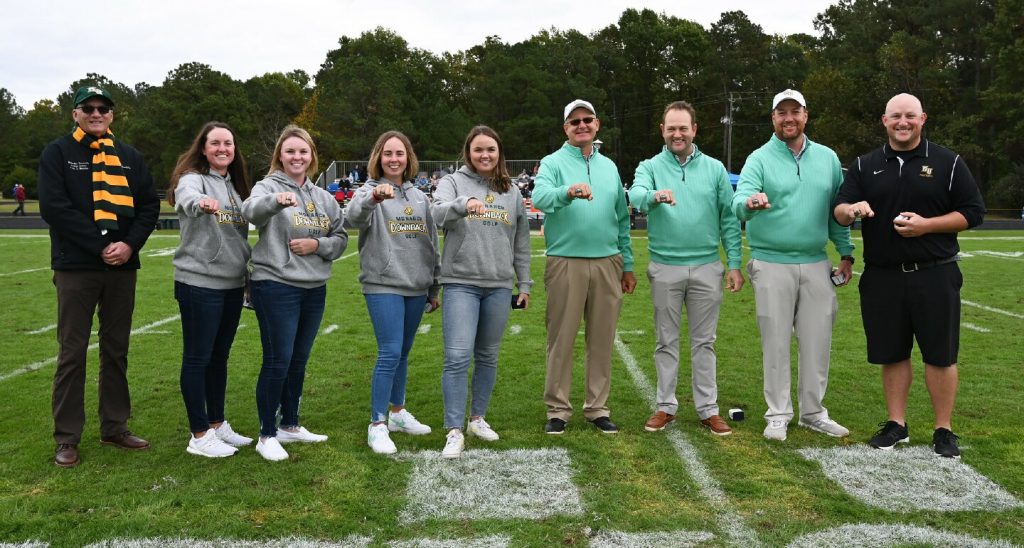
In October 2021, Methodist University received the largest gift in school history—a $14 million bequest from the estate of Robert J. Chaffin. With $1.5 million earmarked for the Nursing Program, the Nursing Building was renamed in his honor. Eight years after Price Field, the home of MU Softball, was dedicated, the ribbon was cut on the Price Softball Field House in March 2022. Continuing a big year for Institutional Advancement, the family of the late Dr. Frank P. Stout, a former Trustee of Methodist University, donated $1.5 million for the Physician Assistant Program, and the program’s Academic Building and Medical Lecture Hall will be named for him.
In February 2023, Methodist University and Cape Fear Valley Health announced a new partnership with the intent to establish the state-of-the-art Methodist University medical school that will train the next generation of healthcare professionals. With an anticipated first cohort enrolled in 2026, the new medical school, to be located on the campus of Cape Fear Valley Medical Center in Fayetteville, will combine the expertise and resources of both institutions to provide students with unparalleled educational and clinical experiences.
